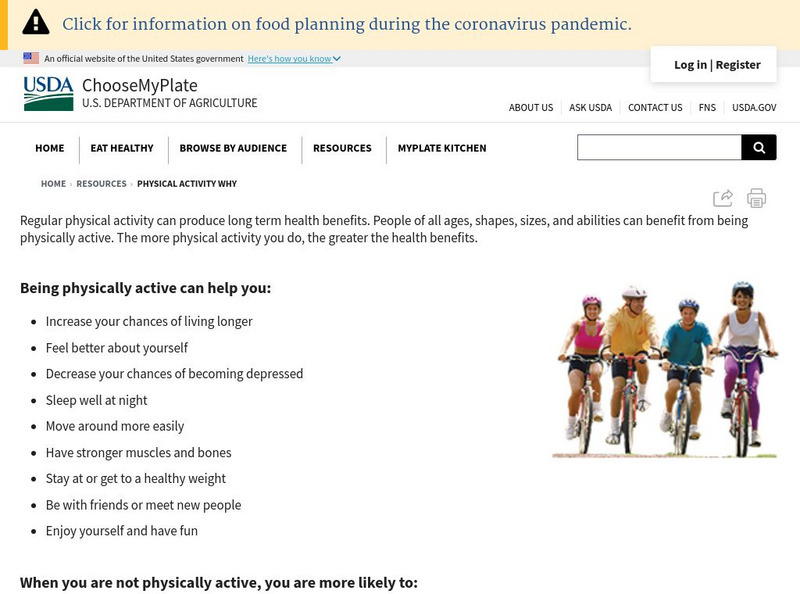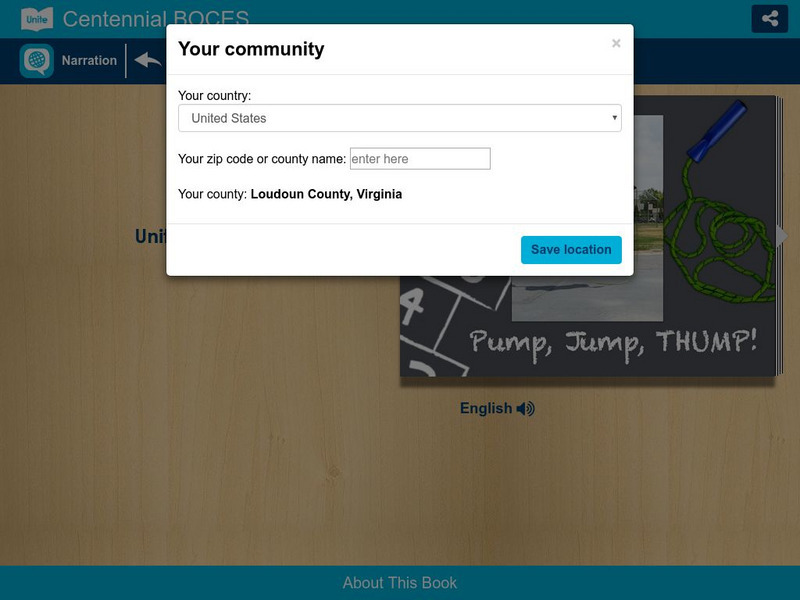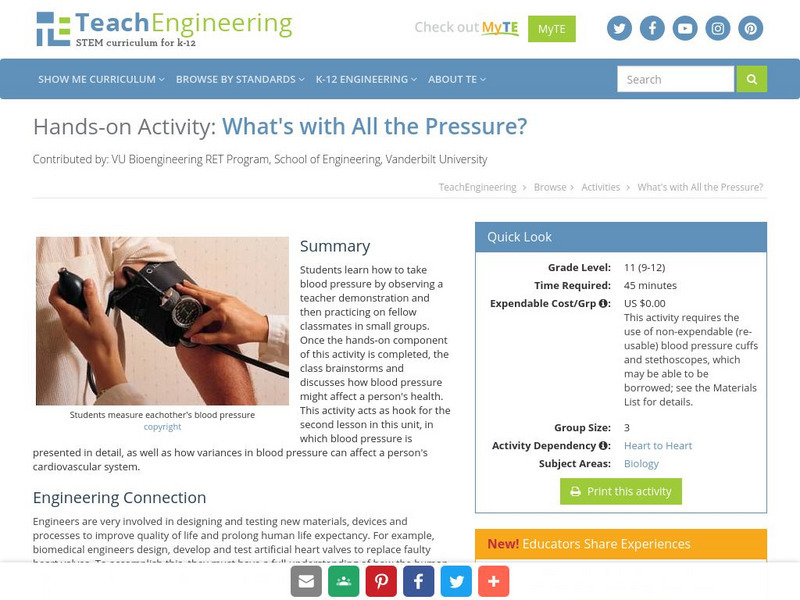Hi, what do you want to do?
National Cancer Institute at the National Institutes of Health
Seer Training Modules: Introduction to the Cardiovascular System
Self-guided learning activity where students learn about the structure and function of the human cardiovascular system. There is a short quiz at the end of the lesson to check for understanding.
Science Buddies
Science Buddies: Heart Health: How Does Heart Rate Change With Exercise?
Your heart starts beating before you are born and keeps right on going through your whole life. Over an average lifetime, the human heart beats more than 2.5 billion times. Keeping your heart healthy means eating right, not smoking, and...
Department of Defense
Do Dea: Physical Fitness Activity
Exercise must be performed regularly throughout life to achieve the benefits of physical fitness, wellness, and disease prevention. In this self-guided unit, you will be introduced to the components of fitness, principles of exercise,...
American Heart Association
American Heart Association: Getting Healthy: Physical Activity: Get Moving!
Learn about the health benefits of exercise. Content includes helpful tips on how to incorporate activity into your daily life and a link to the association's guidelines for improving heart health through fitness.
US Department of Agriculture
Choose My Plate: Why Is Physical Activity Important?
This site includes a simple list of reasons why getting exercise is important for your physical and emotional well-being. Also, learn definitions and examples of aerobic activities, resistance activities, and stretching activities.
Curated OER
Kids Health: How the Body Works Movies and Activities
Short, colorful movies explain each of the body's systems: skeletal, cardiovascular, digestive, urinary, respiratory, endocrine, skin, immune, muscular, and nervous. Once you've seen the movie, click on the Activity Page link for...
Other
Wellness Junction: Exercise Improves Cardiovascular
This brief article from Wellness Junction summarizes research linking aerobic and anaerobic exercise to improved cardiovascular conditions in those with diabetes and high blood pressure. Provided is a list of recommended exercises for...
TeachEngineering
Teach Engineering: Body Circulation
Middle schoolers are introduced to the circulatory system, the heart, and blood flow in the human body. Through guided pre-reading, during-reading and post-reading activities, students learn about the circulatory system's parts,...
TeachEngineering
Teach Engineering: The Heart of Our Cardiovascular System
Students learn about the heart and its role at the center of the human cardiovascular system. In the associated activity, students play out a scenario in which they are biomedical engineers asked to design artificial hearts. They learn...
TeachEngineering
Teach Engineering: Electrocardiograph Building
This activity will build upon the concepts taught in the lesson The Strongest Pump of All. The activity will pull together the concepts of bioelectricity, electrical circuits, and biology. It will allow the students the opportunity to...
TeachEngineering
Teach Engineering: Artificial Heart Design Challenge
Students are presented with a hypothetical scenario in which they are biomedical engineers asked to design artificial hearts. Using the engineering design process as a guide, the challenge is established and students brainstorm to list...
Centers for Disease Control and Prevention
Centers for Disease Control: Physical Activity and Health at a Glance
This website provides notes on exercise, its health benefits, and its role in helping all people feel healthier and stronger. Learn about different types of exercises you can do to improve you health. Also, read facts about adults and...
Science Buddies
Science Buddies: A Day in the Life of Your Heart
Heart rates can be determined by the amount of physical activity your body is engaging in. The more physically active you are, the faster your heart beats. You can measure the rate your heart is beating by taking your pulse. This science...
Sesame Street
Sesame Street: Healthy Habits for Life
This comprehensive resource will give you the tools you need to teach children about eating right and being physically active so that they can establish healthy habits for life. Included are easy-to-use, fun lessons and activities that...
Unite for Literacy
Unite for Literacy: Cboces: Migrant Education Program: Pump, Jump, Thump!
Shows activities children do that keep their hearts healthy. Includes audio narration in 13 additional languages with text in English.
Other
Prevent Disease: Exercise & Preventing Disease
This web-article discusses how exercise not only helps prevent disease, but also improves the health of those who have certain medical conditions. Learn how physical activity helps individuals battle cardiovascular and musculoskeletal...
PE Central
Pe Central: Water Fitness
Find ideas for water fitness and aerobics at this website. While in a pool, you can use kickboards, water jugs, fins, and water resistant equipment as you participate in a variety of activities: a warm-up, stretches, cardiovascular...
CK-12 Foundation
Ck 12: Life Science: Muscles and Exercise
[Free Registration/Login may be required to access all resource tools.] Regular physical exercise is important in preventing lifestyle diseases such as cardiovascular disease, some types of cancer, type 2 diabetes, and obesity. Regular...
TeachEngineering
Teach Engineering: What's With All the Pressure?
Students learn how to take blood pressure by observing a teacher demonstration and then practicing on fellow classmates in small groups. Once the hands-on component of this activity is completed, the class brainstorms and discusses how...
TeachEngineering
Teach Engineering: Saving a Life: Heart Valve Replacement
Students use their knowledge about how healthy heart valves function to design, construct and implant prototype replacement mitral valves for hypothetical patients' hearts. Building on what they learned in the associated lesson about...
PE Central
Pe Central: Pe Lesson Ideas: Aerobic Frisbee Golf
The physical activity described at this website combines cardiovascular fitness exercises (frisbee, push-ups, jumping jacks) and academic subjects math and science.
National Institutes of Health
National Library of Medicine: Your Beating Heart
In this lesson plan site, the students will learn about the circulatory system and perform an experiment where they take their pulse after various activities.
Other
Kqed: The Lowdown: Life Expectancy: Finding Ratio Relationships
In this interactive map, learn how life expectancy, obesity, hypertension, and physical activity rates have changed dramatically throughout the United States over the last three decades.
Science Museum of Minnesota
Lesson Plan: Pulse of Life
Students measure their pulse rate and explore how heart rate is affected by various activities.






















